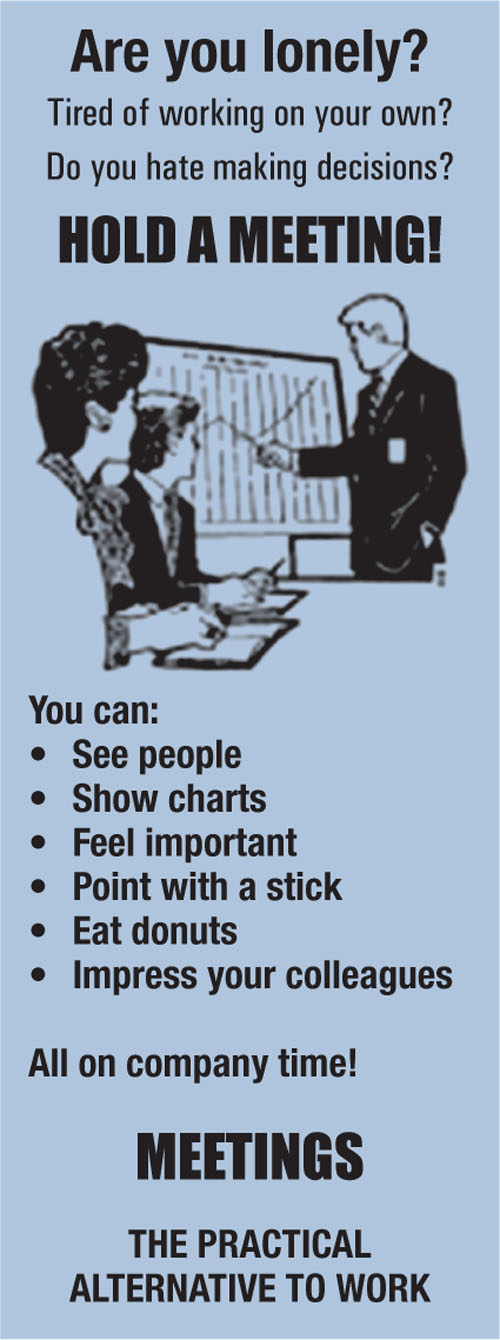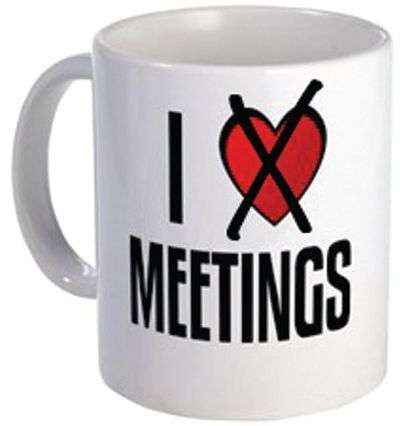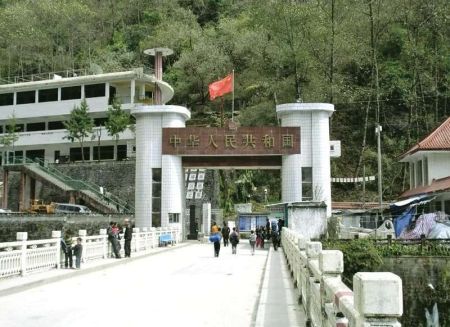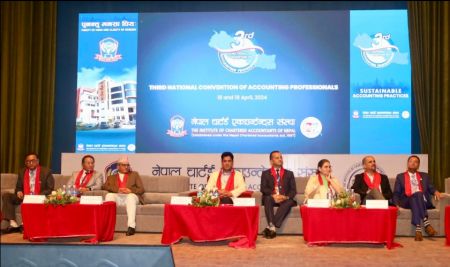A meeting is an affirmation. It affirms the identity, the role, the existence of each of its members.
--By Vaijayanti Khare
A meeting is an alliance. Each person sitting there endorses a coming together of ideas and direction. Even a dissent, a disagreement and an argument are a valuable dimension of the discussion. In fact, it is a strategic alliance for it brings together the varied competencies of the attendees towards the points of conversation.
A meeting is an affirmation. It affirms the identity, the role, the existence of each of its members. And that of the entire group at the meeting. It is an affirmation of each person’s relation with the organisation, with the others at the meeting, and of course, with himself. It is an affirmation of the role, the ability and the confidence of each person. Even a negation is in fact an affirmation.
I am sure you rarely thought of a meeting as this. Perhaps, you began this page by relating to the picture in the box. I put that there with a reason. I can see that you ‘grabbed’ that mug. Let me help you ‘drop’ it!
A meeting, above all, is what you bring to it. What you make of it. And, what you take away from it. You may be the lead chair, a senior or mid-senior member or a new entrant on a meeting, and yet you are the meeting maker. There can be no observers or ‘i-care-a-damn’ member – such a person should rather excuse herself from the meeting.
A meeting is one of the best places for the Meaning Quotient of you as an individual, you as an organisation and you as the relation and equation of both these. Do not be fooled by convenient jargon like internal meeting, external meeting, meeting with clients, meeting with employee, high-end meeting ….the list can be endless. Each meeting is as important as the other, if you respect yourself. Each meeting is a value you put in or give yourself.
A meeting is a therapy. It is a point in time, a location in space; and like a Cartesian grid it is where you are placed. It allows you to harness all your energies and that of the others around you, and it is the place for decisions, direction, assimilation, connections and completion. A meeting should ideally make you more you, if you understand it as such. It therefore heals, rejuvenates, makes anew, rebuilds and reinforces.
If you think I am talking meta-physics, then what can be simpler than a meeting to realise your metaphysical self?! !
Each aspect of a meeting may have been talked about by your communication trainers, written out in management text books, discussed at the meetings and more often outside the meetings. And you feel that nothing changes about the meetings. Well, that’s not surprising – because you have not changed anything about yourself or about the meetings yourself!! You think some ‘outside’ force is responsible for that change.
Meetings drone on, and are made into the waste-of-time, the ineffective and the meaningless exercise it seems because most have lost the purpose of a meeting, or even worse, lost their own purpose of being in that position, role, organisation et al.
Any meeting can become a ‘drag’ even before it begins. Every person is responsible for changing that.
The essential elements of a meeting are objective, time, process and summation. A meeting is meaningful when it achieves objectives,when it takes up a minimum amount of time and when you feel that a sensible process has been followed. A meaningful, effective meeting can be the norm and not the exception when one structures the planning, preparation, execution, and follow up around three basic criteria.
Objective: An effective meeting serves a useful purpose. This means that in it, you achieve a desired outcome. For a meeting to meet this outcome, or objective, you have to be clear about what it is. Too often, people call a meeting to discuss something without really considering what a good outcome would be. Clearly spell out the objective of each point on the agenda – a decision? Generate ideas? A status report? Information? A plan? And such. With the end result clearly defined, you can then plan the contents of the meeting, and determine who needs to be present.
It is imperative that an agenda be made and sent out well in advance even if it is a routine, scheduled meeting. To prepare an agenda, consider the following factors:
• Priorities – what must be covered?
• Results – what do you need to accomplish?
• Participants – who needs to attend?
• Sequence – in what order will you cover the topics?
• Timing – how much time will you spend on each topic?
• Date and Time – when will the meeting take place?
• Place – where will the meeting be? The arrangements needed?

Starting with your meeting objective, everything that happens in the meeting should further that objective. If it is superfluous, it should not be included. With an idea of what needs to be covered and for how long, you can then look at the information that should be prepared beforehand. What do the participants need to know in order to make the most of the meeting time? And, what role are they expected to perform in the meeting, so that they can come prepared.
If it is a meeting to solve a problem, ask the participants to come with suggestions of a viable solution. If you are discussing an ongoing project, have each participant summarise her progress to date and circulate the report beforehand, ideally. Assigning a particular topic of discussion to a relevant person is a good practice to increase involvement and interest. On the agenda, indicate who will lead the discussion or presentation of each item.
Use your agenda as your time guide. When you notice that time is running out for a particular item, consider hurrying the discussion, pushing to a decision, deferring discussion until another time, or assigning it for discussion by a subcommittee. An important aspect of running effective meetings is insisting that everyone respects the time allotted. Start the meeting on time, do not spend time recapping for latecomers, and, when you can, finish on time.
Sensible Process: Begin sensibly by preparing and circulating agenda. Invite feedback and inputs. Spread the feeling of participation rather than being dictatorial. Perhaps there is something important that a member wishes to add. Maybe you have allotted too much, or too little, time for a particular item. There may even be some points you have included that have been settled already and can be taken off the list for discussion. It is important you get feedback from the meeting participants about the proposed agenda.
Proceed sensibly and sensitively. If certain people are dominating the conversation, make a point of asking others for their ideas. At the end of each agenda item, quickly summarise what was said, and ask people to confirm that that's a fair summary. Then make notes regarding follow-ups. Note items that require further discussion. Watch body language and make adjustments as necessary. Maybe you need a break, or you need to stop someone from speaking too much. Ensure the meeting stays on topic. List all tasks that are generated at the meeting. Make a note of who is assigned to do what, and by when. At the close of the meeting, quickly summarise the next steps and inform everyone that you will be sending out a meeting summary.
After the meeting is over, take some time to debrief, and determine what went well and what could have been done better. Evaluate the effectiveness based on how well you met the objective. This will help you continue to improve your process of running effective meetings.
Finally, prepare the meeting summary, circulate to all participants and other stakeholders. It is a record of what was accomplished and who is responsible for what as the team moves forward. This is a very crucial part of effective meetings that often gets overlooked. You need a written record of what transpired, along with a list of actions that named individuals have been assigned to perform. Make sure someone is assigned to take notes during the meeting if you think you will be too busy to do so yourself.
It is easy to make the ‘meetings’ in your Organisation a ‘culture statement’. It is a simple way of inculcating values of respect, purpose, integrity and performance. Ever thought of having a ‘rating’ system for all your meetings, making it a criteria for ‘performance of a unit or department’, having a ‘meeting mentor’ to bring about the necessary change in the way you meet. A ‘Meeting’ is a strong ‘Change agent’ in itself, let us harness it.
Vaijayanti Khare is known for her dynamic engagements in the corporate, academic, social and development fields in Kathmandu over the past decade. Her writings are a reflection of her hands-on work, insights, studies, success and challenges.






















